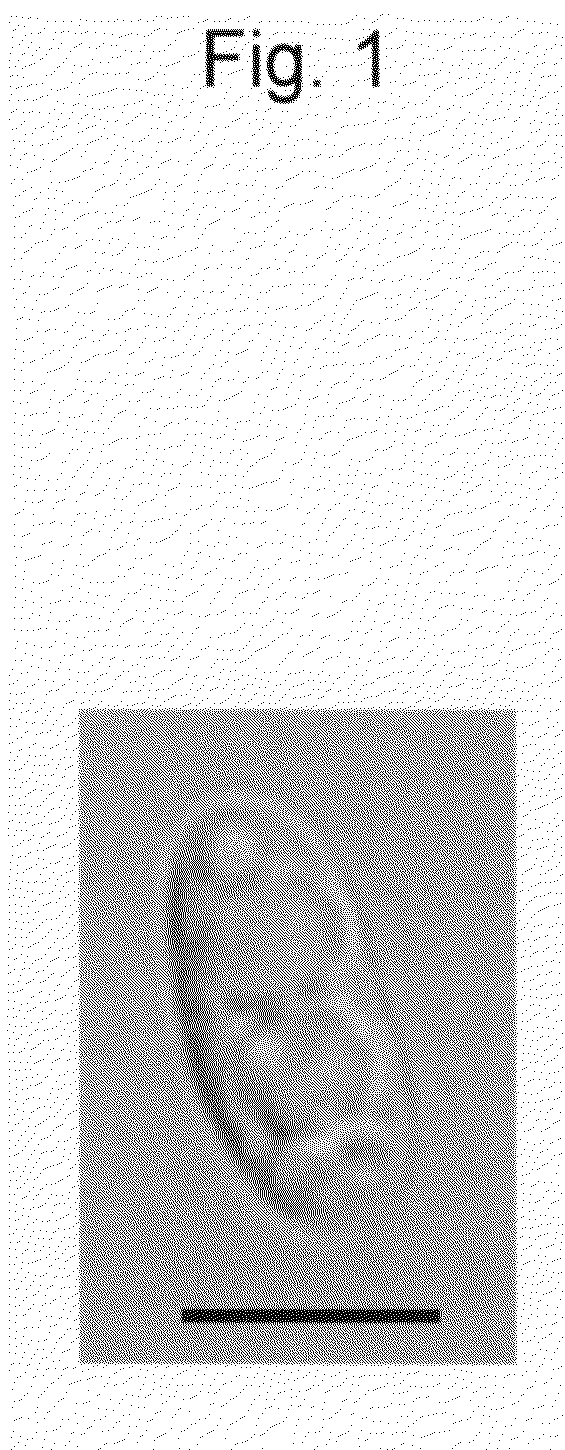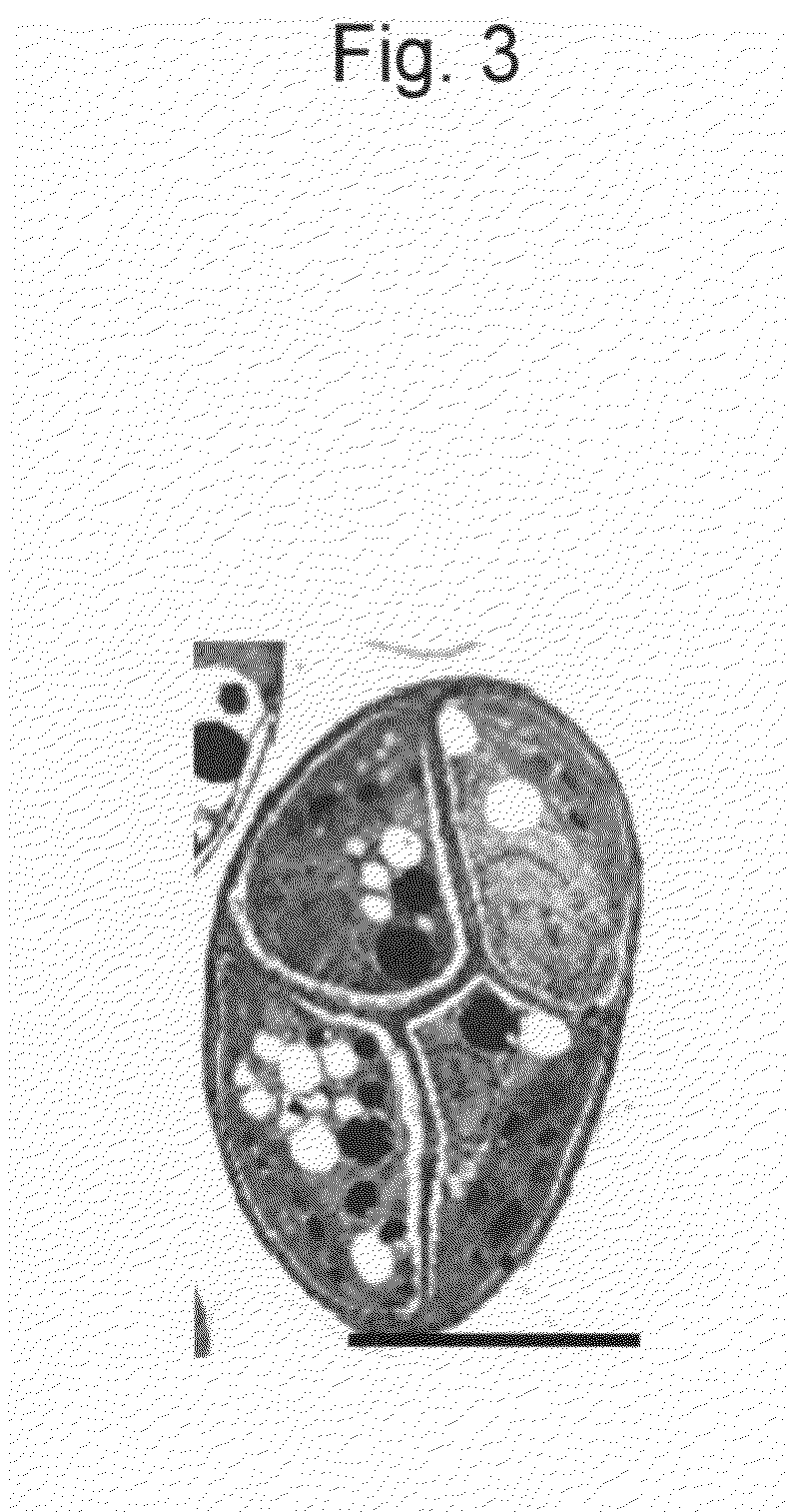Novel Microalga and Process for Producing Hydrocarbon
a technology of microalga and hydrocarbon, applied in the field of microalga, can solve the problems of low net yield of hydrocarbon, inability to proliferate or produce hydrocarbons at unsatisfactory levels, and no case is known, and achieve the effect of reducing carbon dioxide emissions and no environmental load
- Summary
- Abstract
- Description
- Claims
- Application Information
AI Technical Summary
Benefits of technology
Problems solved by technology
Method used
Image
Examples
example 1
[0067]An A5 medium having the composition shown in Table 2 below was prepared using deionized water. This A5 medium was placed in a flat glass flask (working volume: 500 ml) and autoclaved.
TABLE 2A5 medium compositionNaNO3150mgMgSO4•7H2O10mgKH2PO43.5mgK2HPO44.5mgCaCl2•2H2O0.9mgFe-EDTA1.2mlMetal solution0.1mlDesalted water99.8mlpH7.5Metal solutionH3BO37mgMnSO4•7H2O15mgZnSO4•7H2O30mgCuSO4•5H2O30mgNa2MoO40.3mgCoCl27mgDesalted water100ml
[0068]A Pseudochoricystis ellipsoidea Sekiguchi et Kurano gen. et sp. nov. MBIC11204 strain (hereinafter, referred to as the MBIC11204 strain) was inoculated to the A5 medium. A breathable stopper Was put on the flask, and the culture medium in the flask was stirred and simultaneously aerated with air supplemented with 3% CO2. In this procedure, the flask was irradiated with the light of a white fluorescent lamp from around the flask, and its temperature was adjusted to approximately 28° C. by dipping the flask in a temperature-controlled water bath. The...
example 2
[0070]The cultured microalgal cells (300 ml) obtained in Example 1 were collected by centrifugation and then freeze-dried. The dry weight of the microalgal cells was 721.7 mg under the nitrogen-deficient conditions and 884.7 mg under the nitrogen-containing conditions. Fat-soluble compounds were semi-purified with 10 ml of n-hexane per 200 mg of the dried microalgal cells. The 10-ml aliquot of the extract was then condensed to 1 ml or less using nitrogen gas. Before measurement, the resulting condensate was brought to 1 ml and used as a sample for GC-MS analysis.
[0071]A capillary column used for GC-MS analysis was DB-5 (J&W; 30 m×0.25 mm). A measurement instrument used was GCMS-QP5000 (Shimadzu Corp). Ionization methods used were electron ionization (EI) and chemical ionization (CI) methods. A linear saturated hydrocarbon mixture (C11, C13, C15, C17, C19, C20, C22, C24, C26, C28, C30) standard sample (GL Sciences) was used for identifying components.
[0072]GC-MS conditions are as fol...
example 3
[0087]The MBIC11204 strain was inoculated to each of culture media (already autoclaved) prepared by respectively adding 3 kinds of buffer solutions (50 mM MES (pH 5.5), 50 mM MOPS (pH 7.0), and 50 mM CHES (pH 9.0)) to a C medium having the composition shown in Table 3 below, and cultured in the same way as in Example 1. In this way, the influence of pH of the culture medium on cell growth was evaluated.
[0088]As shown in FIG. 12, the most favorable growth was obtained at pH 7.0. Because the concentrations of the buffer solutions were set to 50 mM, pH was stable during the culture.
TABLE 3C medium compositionCa(NO3)2•4H2O15mgKNO310mgMgSO4•7H2O4mgSodium β-glycerophosphate5mgVitamin B11μgVitamin B120.01μgBiotin0.01μgTris buffer50mgPIV metal solution0.3mlDesalted water99.7mlPIV metal solutionFeCl3•6H2O19.6mgMnCl2•4H2O3.6mgZnCl21.05mgCoCl2•6H2O0.4mgNa2MoO4•2H2O0.25mgNa2EDTA•2H2O100mgDesalted water100ml
PUM
| Property | Measurement | Unit |
|---|---|---|
| excitation wavelength | aaaaa | aaaaa |
| temperature | aaaaa | aaaaa |
| volume | aaaaa | aaaaa |
Abstract
Description
Claims
Application Information
 Login to View More
Login to View More - R&D
- Intellectual Property
- Life Sciences
- Materials
- Tech Scout
- Unparalleled Data Quality
- Higher Quality Content
- 60% Fewer Hallucinations
Browse by: Latest US Patents, China's latest patents, Technical Efficacy Thesaurus, Application Domain, Technology Topic, Popular Technical Reports.
© 2025 PatSnap. All rights reserved.Legal|Privacy policy|Modern Slavery Act Transparency Statement|Sitemap|About US| Contact US: help@patsnap.com



